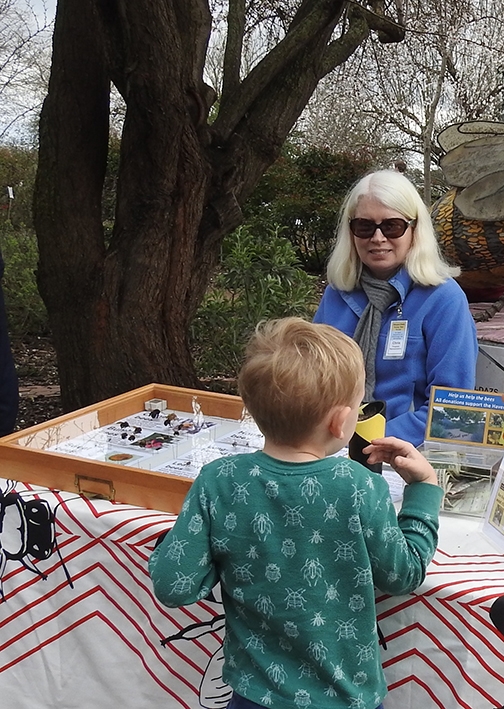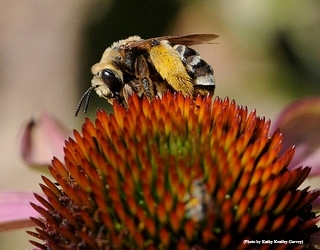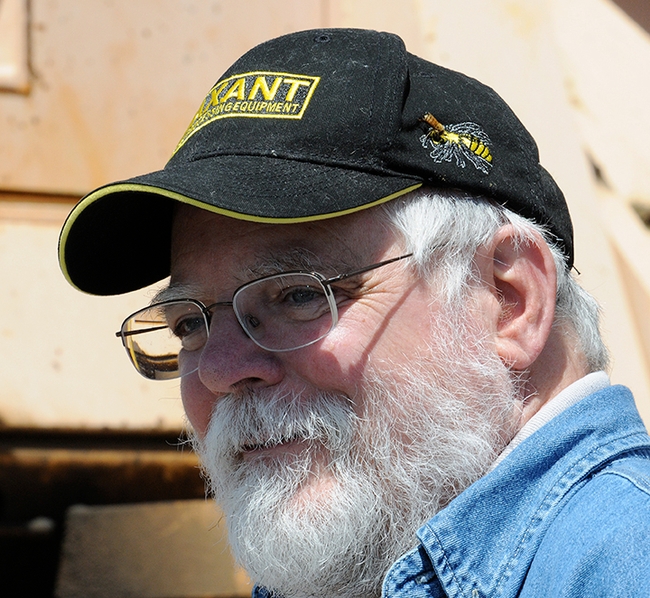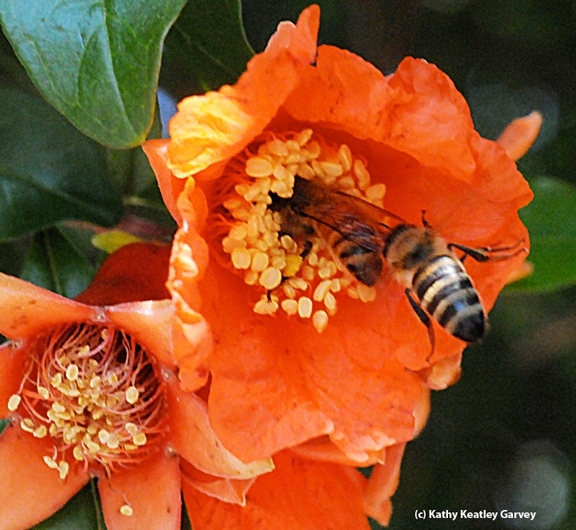- Author: Kathy Keatley Garvey

That's when the UC Davis Department of Entomology and Nematology will celebrate the 15th anniversary of its bee garden with an open house from 10 a.m. to noon. It's free and family friendly.
The half-acre garden is located next to the Harry H. Laidlaw Jr. Honey Research Facility on Bee Biology Road, west of the central campus.
The open house will include a tour of the garden at 11 a.m.; catch-and-release bee activity to observe bees up close; information about low-water plants; and presentations on University of California pollinator research.
Open from dawn to dusk (free admission), the Bee Haven is described as "a unique outdoor museum that provides resources for local bee pollinators, inspires and educates visitors to create pollinator habitat gardens, and provides a site for the observation and study of bees and the plants that support them."
Director of the garden is Elina Lastro Niño, associate professor of Cooperative Extension - Apiculture, UC Davis Department of Entomology and Nematology. Christine Casey is the manager, the academic program management officer.
The garden was installed in the fall of 2009, under the tenure of interim department chair Lynn Kimsey, now UC Davis distinguished professor emerita, and with primary funds from the Häagen-Dazs ice cream brand. Featuring a series of interconnected gardens with names like “Honeycomb Hideout,” “Nectar Nook” and “Pollinator Patch,” it was designed to provide the Laidlaw honey bees with a year-around food source, raise public awareness about the plight of honey bees, encourage visitors to plant bee-friendly gardens of their own, and serve as a research site.
“This garden is a living laboratory to educate, inspire and engage people of all ages in the serious work of helping to save honey bees,” said Dori Bailey, then director of Haagen-Dazs Consumer Communications.

Art graces the garden, thanks to the UC Davis Art/Science Fusion Program, founded and directed by entomologist-artist Diane Ullman, UC Davis distinguished professor of entomology; and Davis-based artist Donna Billick. Billick, a self-described "rock artist," sculpted the six-foot-long worker bee that anchors the haven. Students and area residents crafted the bee-motif ceramic tiles that line a bench, which also includes the names of major donors.
A mural featuring native bees graces the shed in the garden. It was a project of the Entomology 1 class, "Art, Science and the World of Insects," taught by Ullman and Billick. Then doctoral student Sarah Dalrymple of the Rick Karban lab, served as the graphics project coordinator and teaching assistant, guiding the students on design, creation and installation of the panels. She went on to be named the 2011 recipient of the UC Davis Outstanding Graduate Student Teaching Award and praised for fusing the boundaries of biology, art and culture.
The Bee Haven came to "bee" after officials at the Haagen-Dazs read a research news story on honey bees, written by communication specialist Kathy Keatley Garvey and telephoned her. The article, on "building a better bee," chronicled the plight of honey bees and the work of bee breeder-geneticist Susan Cobey, then manager of the Harry H. Laidlaw Jr. Honey Bee Research Facility and now with Washington State University. Haagen-Dazs served as the primary donor of the garden and also funded the Häagen-Dazs Postdoctoral Fellowship at UC Davis. It went to Michelle Flenniken, an insect virus researcher based at UC San Francisco. She is now a professor at Montana State University.
Links:
Sausalito Team Wins Design Competition
http://ucanr.edu/blogs/blogcore/postdetail.cfm?postnum=15240
Grand Opening Celebration of Honey Bee Garden
http://ucanr.edu/blogs/blogcore/postdetail.cfm?postnum=15249
Eagle Scout Project: Fence Around the Bee Garden
http://ucanr.edu/blogs/blogcore/postdetail.cfm?postnum=10166
Campus Buzzway: Wildflowers
http://ucanr.edu/blogs/blogcore/postdetail.cfm?postnum=15242
Haagen-Dazs Honey Bee Haven: Sacramento Bee Award
(With photo of founding volunteers)
http://ucanr.edu/blogs/blogcore/postdetail.cfm?postnum=10205
Shedding Light on Native Bees
https://ucanr.edu/blogs/blogcore/postdetail.cfm?postnum=27570
For more information on the UC Davis Bee Haven, access the website at https://beegarden.ucdavis.edu.




- Author: Kathy Keatley Garvey
It's bee-ginning to look a lot like Christmas...
All hail our littlest agricultural worker.
European colonists brought the honey bee (Apis mellifera) to what is now the United States in 1622. Specifically, the bees arrived at the Jamestown colony (Virginia). Native Americans nicknamed the honey bee "the white man's fly."
California would have to wait until 1853 for honey bees to arrive. That's when Texas beekeeper Christopher Shelton, brought his colonies to the San Jose area. A plaque outside the international terminal of the San Jose airport documents their arrival.
The plaque, "First Honeybees in California," reads:
"Here, on the 1939-acre Rancho Potrero de Santa Clara, Christopher A. Shelton in early March 1853 introduced the honey bee to California. In Aspinwall, Panama, Shelton purchased 12 bee hives from a New Yorker and transported them by rail, “bongo,” pack mule and steamship to San Francisco. Only enough bees survived to fill one hive, but these quickly propagated, laying the foundation for California's modern beekeeping industry. California registered Landmark No. 945 plaque placed by the State Department of Parks and Recreation in Cooperation with E. Clampus Vitus, Mountain Charlie Chapter No. 1850, and in honor of San Jose City Historian Clyde Arbuckle, March 6, 1982."
According to atlasobscura.com, "In 1853, Texan Christopher A. Shelton purchased 12 hives of bees from an unknown beekeeper in what is now Colon, Panama. The bees, already transported to Panama from New York, were then sent up to San Francisco and Alviso, the nearest port to San Jose, by steamer. They then continued their journey via train and mule to the 1939-acre Rancho Potrero de Santa Clara where Shelton settled."
"Only enough bees to form one hive survived," the Atlas Obscura post related. "These German black bees (Apis mellifera mellifera) endured the tedious trek and were propagated throughout California and soon the whole of the West Coast. Shelton was not so fortunate and died alongside other prominent South Bay Residents of the time on the infamous Jenny Lind steamship explosion just a month after the receipt of his bees. His three hives—it didn't take long for his original stock to multiply—were sold at auction for $110 each, 22 times the price of a beehive on the East Coast."
Ever seen the inside of a hive? That's where the magic begins. You'll see "The Girls": the queen, nurse maids, nannies, royal attendants, builders, architects, dancers, honey tenders, pollen packers, propolis or "glue" specialists, air conditioning and heating technicians, guards, and undertakers.
And in spring, summer and early fall, you'll see "The Boys," the drones. They have one responsibility: reproduction. The drone mates in mid-air with a virgin queen, and then he dies--"and with a smile on his face," according to the UC Cooperative Extension apiculturist Eric Mussen (1944-2022).
As we celebrate Merry Christmas and the New Year, the bees could use some cele-bee-tion, too.
Merry Christmas and Happy New Year from the Bug Squad.



- Author: Kathy Keatley Garvey

Zero. Zilch. Nada.
Just a partridge in a pear tree, 2 turtle doves, 3 French hens, 4 calling birds, 5 gold rings, 6 geese-a-laying, 7 swans-a-swimming, 8 maids a'milking, 9 ladies dancing, 10 lords-a-leaping, and 11 pipers piping.
Where, oh, where, are all the insects?
So we replaced "five gold rings" with "five golden bees." Other insects crawled, hopped, leaped and fluttered into the song. We sang the piece during our 2010 UC Davis Department of Entomology and Nematology holiday party. The lyrics went viral when U.S. News picked it up:
On the first day of Christmas, my true love gave to me, a psyllid in a pear tree.
On the second day of Christmas, my true love gave to me, 2 tortoises beetles and a psyllid in a pear tree
On the third day of Christmas, my true love gave to me, 3 French flies, 2 tortoise beetles and a psyllid in a pear tree
On the fourth day of Christmas, my true love gave to me, 4 calling cicadas, 3 French flies, 2 tortoise beetles and a psyllid in a pear tree
On the fifth day of Christmas, my true love gave to me 5 golden bees, 4 calling cicadas, 3 French flies, 2 tortoise beetles and a psyllid in a pear tree
On the sixth day of Christmas, my true love gave to me 6 lice a'laying, 5 golden bees, 4 calling cicadas, 3 French flies, 2 tortoise beetles and a psyllid in a pear tree
On the seventh day of Christmas, my true love gave to me 7 boatmen swimming, 6 lice a'laying, 5 golden bees, 4 calling cicadas, 3 French flies, 2 tortoise beetles and a psyllid in a pear tree
On the eighth day of Christmas, my true love gave to me 8 ants a'milking aphids, 7 boatmen swimming, 6 lice a'laying, 5 golden bees, 4 calling cicadas, 3 French flies, 2 tortoise beetles and a psyllid in a pear tree
On the ninth day of Christmas, my true love gave to me 9 mayflies dancing, 8 ants a'milking aphids, 7 boatmen swimming, 6 lice a'laying, 5 golden bees, 4 calling cicadas, 3 French flies, 2 tortoise beetles and a psyllid in a pear tree
On the tenth day of Christmas, my true love gave to me 10 locusts leaping, 9 mayflies dancing, 8 ants a'milking aphids, 7 boatmen swimming, 6 lice a'laying, 5 golden bees, 4 calling cicadas, 3 French flies, 2 tortoise beetles and a psyllid in a pear tree
On the 11th day of Christmas, my true love gave to me 11 queen bees piping, 10 locusts leaping, 9 mayflies dancing, 8 ants a'milking aphids, 7 boatmen swimming, 6 lice a'laying, 5 golden bees, 4 calling cicadas, 3 French flies, 2 tortoise beetles and a psyllid in a pear tree
On the 12th day of Christmas, my true love gave to me 12 deathwatch beetles drumming, 11 queen bees piping, 10 locusts leaping, 9 mayflies dancing, 8 ants a'milking aphids, 7 boatmen swimming, 6 lice a'laying, 5 golden bees, 4 calling cicadas, 3 French flies, 2 tortoise beetles and a psyllid in a pear tree
"On the 13th day of Christmas, Californians woke to see: 13 Kaphra beetles, ?12 Diaprepes weevils, ?11 citrus psyllids, ?10 Tropilaelaps clareae, ?9 melon fruit flies, 8 Aedes aegypti, 7 ash tree borers, 6 six spotted-wing Drosophila, 5 ?five gypsy moths, 4 Japanese beetles, 3 imported fire ants, 2 brown apple moths, and a medfly in a pear tree."
Today the song is still making the rounds, but with some different pests--pests that challenge entomologists in the California Department of Food and Agriculture:
On the first day of Christmas, my true love gave to me, a psyllid in a pear tree.
One the second day of Christmas, my true love gave to me, two peach fruit flies
On the third day of Christmas, my true love gave to me, three false codling moths
On the fourth day of Christmas, my true love gave to me, four peach fruit flies
On the fifth day of Christmas, my true love gave to me, five gypsy moths
On the sixth day of Christmas, my true love gave to me, six white striped fruit flies
On the seventh day of Christmas, my true love gave to me, seven imported fire ants
On the eighth day of Christmas, my true love gave to me, eight longhorn beetles
On the ninth day of Christmas, my true love gave to me, nine melon fruit flies
On the 10th day of Christmas, my true love gave to me, ten brown apple moths
On the 11th day of Christmas, my true love gave to me, eleven citrus psyllids
On the 12th day of Christmas, my true love gave to me, twelve guava fruit flies.
On the 13th day of Christmas, my true love gave to me, thirteen Japanese beetles
And, then, of course, there's that dratted pest, the Varroa destructor (varroa mite) from Asia, which arrived in the United States in 1987. Known as the No. 1 enemy of beekeepers, this external parasitic mite feeds on fat body tissue, and can transmit debilitating viruses. This is not what you want for Christmas--or any other time.
'Tis the season to celebrate the holidays...and to check your Yule tree branches for a praying mantis egg case (ootheca).


- Author: Kathy Keatley Garvey
It's a week before Christmas and it's not just the geese that are getting fat.
If you're thinking that the bathroom scale and you are not good friends, not to worry.
We remember the late Extension apiculturist emeritus Eric Mussen (1944-2022) of the UC Davis Department of Entomology, emphasizing the massive weight gain that occurs during the larval stage of the honey bee. He used to speak at scores of beekeeping functions throughout the year, and every time he talked about larval weight gain, he always drew a "Wow!" or "Incredible!" or "Amazing!"
"A honey bee egg weighs about 0.1 mg," Mussen told us. "The first stage larva weighs the same. Over the next six days of larval life the larva goes from 0.1 mg to around 120 mg. It defecates once, just before pupating, and the resulting adult bee weighs around 110 mg. Thus, the new bee weighs about 1,000 times the weight of the one-day-old larva."
Now get this:
"If a human baby, weighing eight pounds at birth, were to grow at the same rate, the baby would weigh 8,000 pounds, or 4 tons, at the end of six days."
Four tons in six days? Fortunately, what goes on with Apis mellifera does not apply to Homo sapiens.




- Author: Kathy Keatley Garvey

A resident of Medina, Ohio, Kim died Sunday, Dec. 10 at his home of lung cancer at age 76. He served as editor of Bee Culture for 33 years, retiring in 2019. He authored numerous books and podcasts, including "5000 Years of Beekeeping in 24 Minutes (100)" with Jim Tew on Honey Bee Obscura.
We remember his talk at the 2021 California Honey Festival.
"If you want to be a beekeeper, you must think like a bee, not like a beekeeper," he related.
As a descendant of generations of beekeepers, I asked Kim why folks should keep bees. They "provide essential pollination, improve the genetics of the wild bee population in the area, ensure native plant populations," he said, "and because there is absolutely nothing more calming, soothing, enjoyable than being a part of that civilization, right in your backyard."
We remember when Kim addressed the 2017 Western Apicultural Society's 40th annual conference, held at UC Davis, where it was founded. He predicted that the nation's 250,000 beekeepers (who manage around 4 million colonies) will turn into a million beekeepers in five years.
Kim applauded "the incredible rise of new beekeepers in the last 10 years."
"The urban, suburban and country beekeepers are younger than the norm and we have more women beekeepers than ever," Kim told the crowd. "This isn't like the 1970s Green Movement--I'm old enough to remember that. It's got legs! But watch out for an ugly urban disaster like a major bee spill or bad honey recall."

"If I'm in beekeeping, pollination services is a sure bet," he said. "Beekeepers now get 200 bucks a colony for almond pollination in California. Pollination is more profitable than honey. Bee breeding? Queens can sell for as much as $40 or $50."
"In the United States, we eat on the average 1.2 pounds a year, but in Canada, it's 2.5 or 2.4 pounds." He lamented that unsafe and/or questionable honey from China floods our nation's supermarkets and is being sold at undercut prices. (Some statistics indicate that a "third or more of all the honey consumed in the U.S. is likely to have been smuggled in from China and may be tainted with illegal antibiotics and heavy metals"--Food Safety News.)
It's important for American beekeepers to label their honey "Made in America" or localize it by city or state, Kim said.
He also touched on such issues as honey bee health, nutrition, loss of habitat, poor quality forage, and pesticides.
The varroa mite/virus is the No. 1 problem for beekeepers, he said. "Other stressers include nutrition, nosema, pesticides...All of these can be fixed with money, increased diversity of bee stock, and a move away from both ag and in-hive legal and illegal chemicals."
Extension apiculturist emeritus Eric Mussen (1944-2022), serving his sixth term as president of WAS in 2017, commented at the time: "Kim Flottum has been a stalwart in U.S. beekeeping for decades. He ferrets out information on national, regional, and local beekeeping happenings and disseminates the news in various places, depending upon his role at the time. He has been associated with the A.I. Root Company; Gleanings in Bee Culture, and now editor of Bee Culture magazine. He is very active in the Eastern Apicultural Society and is well known by nearly every University and USDA scientist in the country. Kim consolidates all that information into some really interesting presentations in which he is not known for concealing his opinions."
Kim Flottum received his bachelor's degree in horticulture production from the University of Wisconsin and then worked as a researcher at the USDA Honey Bee Research Lab in Madison, where he specialized in crop pollination, pesticide problems with honey bees, and "honey plants" for the home landscape.
His career took him to Connecticut. He was elected president of Connecticut Beekeepers' Association. He served as publications manager and editor of Gleanings In Bee Culture, A. I. Root's monthly beekeeping magazine. He created a new magazine, BEEKeeping, Your First Three Years. He also served as president of the Ohio State Beekeepers' Association. He continued to keep bees in his backyard in Medina up until his death.
The son of the late Arnold and Edna Flottum of Turtle Lake, Wisc., Kim is survived by his wife, Kathy, of Medina; a daughter, Jessica of Akron; two stepsons, Matt and Grant Summers, both of Medina; and two brothers and two sisters, all from Wisconsin: Julie (Flottum) Hugg of Ashland; Bob Flottum of Chippewa Falls; Susan Flottum Zurcher of Wales; and Tom Flottum of Turtle Lake. A celebration of life is planned next spring. (See obituary)
A post on his Facebook page said simply: "RIP, Kim Flottum, you will be missed by all beekeepers."
And the bees.
His passion for bees, his wisdom about all things bees, his generosity, and his kindness, will never be forgotten.



